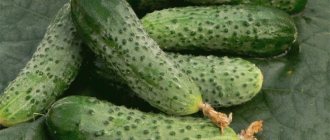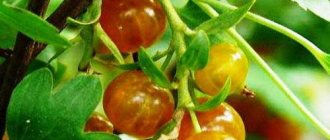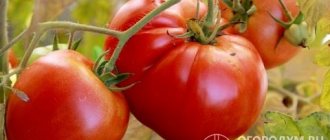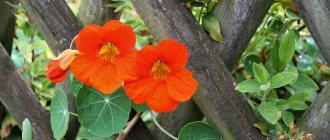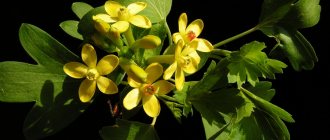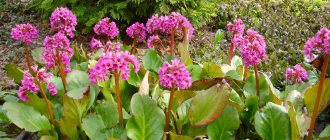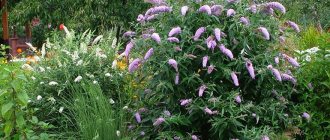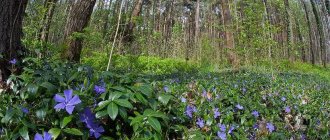“Courage F1” cucumbers are already well known to many summer residents and greenhouse owners who consider this hybrid a worthy alternative to the vaunted “Dutch”. “Courage F1” is one of the leaders among Russian cucumbers, bred and patented by agro.
In the photo - a fragment of the packaging of hybrid seeds produced by the breeding and seed production company
The cucumber hybrid “Courage F1” was included in the State Register of the Russian Federation in 2002, and was also included in the registers of Ukraine and Belarus. It is recommended for cultivation in all regions of Russia in spring-summer and summer-autumn rotations under film shelters : in film, glazed or polycarbonate greenhouses. In the southern regions (Stavropol Territory, Krasnodar Territory, Rostov Region), it is successfully cultivated when planted in open ground due to the plants’ high tolerance to adverse weather conditions: temperature changes, high or low humidity. As confirmation, we invite you to watch the following video.
The most valuable qualities of a hybrid include:
| Index | Characteristic |
| Precocity | Enters active fruiting from the 40-43rd day after full germination |
| High yield | Commercial yield from 1 kg/m2 is 16-18 kg (under film covers) |
| Versatility of purpose | Short-fruited and lumpy greens, their excellent taste in fresh and canned form |
| Disease resistance | Resistant to true and downy mildew, root rot |
Let us now consider in more detail the main characteristics.
How the variety appeared
When Russian breeders were tasked with developing a new variety of cucumbers that would meet the wishes of gardeners in our climate, agro specialists got down to business. Breeders have developed a variety that is distinguished by a bouquet type of ovary placement, resistant to many diseases, and does not require pollination by insects - parthenocarpic. The variety was named Courage and registered in 2002.
The variety went “to the people”, was tested in the beds of Moscow gardeners and received recognition. Many bunches, in which 10-12 fruits were located at once, ensured a good harvest, and they required space and care, as for an ordinary cucumber - this made the variety popular.
Preparing the planting site in the greenhouse
Cucumber Courage F1 (the description will tell novice growers of the crop how to properly prepare a planting site in a greenhouse) is well cultivated in light soil cover, which contains a high volume of humus. Fertile black soil, sandy loam or loamy soil layer is suitable for the plant. Before planting cucumber seedlings, it is necessary to prepare the soil cover in advance.
To do this, follow these steps:
- In the autumn, organic compounds will need to be sent into the ground. It is necessary to mix 70 g of nitroammophoska with 3 glasses of ash and 3 buckets of manure. The composition is designed for 1 m2.
- With the arrival of the spring season, the soil layer needs to be dug up using the bayonet of a shovel.
- Then the soil should be fed with compost. For 1 m2 you will need 1 bucket of organic composition.
The cucumber will be cultivated normally in the area where carrots, cabbage, onions, potatoes and legumes were previously grown. Melon crops with pumpkin, melon and watermelon are considered bad predecessors.
Description and characteristics of the variety
Cucumbers of this variety are pimply, have medium tubercles, usually even, dark green in color. Mature fruits reach a length of 10-14 cm and a weight of 100-120 g.
Productivity directly depends on the care of the bush and growing conditions:
- in industrial greenhouse conditions, the yield can reach 50 kg per 1 sq.m.;
- on private farms, a cucumber yields 20 kg per square meter, which is quite a lot.
The flowers are located in the axils, form a bouquet ovary, and a lot of fruits are set.
The variety is quite early ripening. The first fruit can be picked 35 days after planting, but the bulk ripens in 45 days.
Important! Cucumbers can be picked at the ripening stage that is convenient for consumption. There is no need to wait for maturity; this fruit is not used in its ripe form.
If Courage is grown in a greenhouse, fruiting begins earlier and lasts a long time. The productivity of one bush increases. The variety can also grow in an ordinary garden bed in open ground. The hybrid is characterized by the fact that it can give good results under the most unfavorable conditions.
Cucumber has a wonderful taste, it can be pickled, pickled, used in salads, or eaten fresh.
Formation of a bush of the Kurazh variety
The main technique that allows you to collect the maximum yield from bunched varieties of cucumber is to form a bush into one stem. To do this, first remove all the side shoots that are starting to grow and the ovaries in the axils of the first 4-5 leaves. As a result of this technique, the cucumber plant begins to direct all its strength and growth energy to the formation of a powerful root system and a large number of leaves, in which nutrients are stored.
Then, after the main stem reaches the upper edge of the trellis (that is, a height of about 2-2.5 meters), only the side shoots are removed from its axils, and all the ovaries are left.
Another option is possible when in the middle part of the main stem one leaf is left in the axils, and in the upper part - two. That is, they pinch the side shoots after the second and third leaves, respectively. Subsequently, the main stem is directed along the upper edge of the trellis and, when the top reaches the neighboring bush, it is pinched.
This formation of a cucumber bush allows the formation and maturation of the maximum number of ovaries.
Advantages and disadvantages
Judging by the characteristics and description of the cucumber variety, F1 Courage has a number of advantages over other varieties.
Advantages
- high taste qualities;
- lack of bitterness;
- resistance to common diseases;
- The photographs show that there are a lot of cucumbers in the ovary, the variety has excellent yield, the bushes yield the harvest together;
- perfectly adapt to any conditions;
- low maintenance requirements;
- the hybrid is recommended for industrial production;
- good keeping quality, long shelf life;
- early ripening;
- does not depend on the presence of insects, since it pollinates independently;
- good for vertical cultivation - saves space and increases productivity.
Flaws
- since the variety produces large yields, it needs good care;
- bush formation is required;
- photophilous, in poor lighting the root system dies;
- This is a hybrid, which means there is no way to collect seeds from your own crop;
- In the absence of care, the yield drops sharply.
Disadvantages are typical not only for the Courage variety, but for any plants.
The variety is suitable for cultivation in open and closed ground. In greenhouses the fruiting period is longer; in open ground the bushes are stronger and more resilient.
Seed preparation
Before planting, seeds must be treated against harmful microorganisms. This is done in several stages:
- Soak the seeds in a saline solution (2 tablespoons of salt per 1 liter of water) for 20 minutes. The floated specimens are not viable, so they need to be discarded.
- Rinse the seeds that have settled to the bottom in warm water and soak for 30 minutes in a pink solution of potassium permanganate at room temperature. To disinfect them, you can also use special preparations, for example, Epin-Extra or Baikal EM-1.
- Wash the seeds thoroughly and place them in a piece of cloth, and then water them generously so that they do not dry out. To provide them with a warm and humid microclimate, the seeds can be placed under a plastic bag. They will hatch on the 4th day. If sprouts do not appear even within a week, then the planting material must be discarded, since it is unsuitable for planting.
- Place the sprouted seeds in a damp cloth on the bottom shelf of the refrigerator and harden them for two days to build their immunity and increase their resistance to stress.
Properly treated seeds of this hybrid have a germination rate of more than 95%.
Planting cucumbers
For greater fruiting, cucumbers should be grown in seedlings. Let's consider the technique of growing seedlings.
To avoid confusion, beginners are offered the following planting plan:
- the seeds are treated with a growth stimulator (zircon, epin), then disinfected - dipped in a solution of potassium permanganate for 1-2 hours;
- seeds are planted to a depth of 1.5-2 cm in heated soil in boxes;
- the boxes are placed in a sunny window;
- until germination, the box with plantings should be kept at a temperature of 25 degrees;
- when the first leaves appear, the temperature is reduced to 18 degrees - it is under such conditions that the sprouts do not stretch, become strong, and acquire a rich green color;
- You need to water the seedlings as the soil dries out; drying out and flooding the soil is detrimental to plantings;
- when the seedlings produce 2-3 leaves (in about a month), they can be transplanted into a greenhouse.
Important! Courage is very light-loving. Choose the sunniest place for planting. If there is little light, the number of cucumber ovaries in the bunch is reduced.
Planting scheme: per 1 sq.m. – 2 plants.
It should be planted on cloudy days or in the evening, when there is no scorching sun rays. Roots that have not taken root will not yet be able to provide the plant with moisture; the bushes will die immediately.
Important! To correctly calculate the timing of planting seeds, remember when the soil in greenhouses or open ground warms up to 15 degrees, count a month from this time - during this time you can plant the seeds.
Productivity
In their recommendations, breeders indicate that exceeding the crop planting density will inevitably lead to loss of yield. 2 plants are planted per 1 m².
The very first cucumbers should be collected when they reach 10 cm, without overcooking the greens. Active harvesting provokes the growth of ovaries, and the yield increases noticeably. If you follow simple recommendations, it is quite possible to collect 10 kg of cucumbers from a bush.
But the second rotation of the harvest will be slightly smaller, and is unlikely to exceed 8 kg per bush. In addition, late sowing also slightly reduces yield, as daylight hours decrease closer to autumn. Therefore, seedlings are planted at the very beginning of summer. The last planting for the autumn harvest takes place at the end of July.
In greenhouses, if additional lighting is available, Courage can be grown year-round.
Excessive foliage of the crop also affects the yield. Large leaves reduce the illumination of the entire plant, smaller foliage turns yellow and dies. Following them, the ovaries slowly die off. To prevent crop loss for this reason, lazy leaf blades are partially removed, but the petioles must be left.
Cucumber care
The cucumber hybrid Courage is not capricious, but requires regular care. Some rules must be followed.
- Watering – water the cucumbers when the top layer of soil dries. Do not overfill - fungal diseases may appear. Lack of moisture causes the plant to wither, drop its fruits, and die.
- Loosening, weeding - loosening is necessary so that an earthen crust does not form, blocking the access of air to the roots. Loosening is carried out after watering, when the water is absorbed. Then it is convenient to carry out weeding - the roots of the weeds are easily pulled out and do not remain in the ground.
- Feeding – cucumbers should be fed with organic matter until the ovaries form. If you feed while the fruit is setting, the cucumbers will acquire an unpleasant taste.
- Forming a bush - the procedure is necessary so that the plant does not waste energy on growing unnecessary green mass. Extra shoots and leaves delay the ripening period, thickening appears, fraught with fungal diseases, and the yield sharply decreases.
Attention! Harvesting bunched Courage cucumbers must be timely. If you delay harvesting even for 1 day, new ovaries will not form, the yield will drop, and the fruits will reduce their taste.
To rejuvenate the cucumber and increase productivity, experienced gardeners use its characteristic feature - the formation of roots at the nodes of the shoots when in moist soil. The shoots are buried with loose, fertile soil mixed with humus. The soil is kept moist, stimulating root formation. An additional root system increases the level of mineral nutrition of the cucumber plant from the soil. Old roots with a reduced ability to absorb minerals are compensated by young ones.
Gardeners' advice! The filling of cucumbers is accelerated if you place a container with fermenting grass in the greenhouse. This will increase the humidity and give the cucumber the carbon dioxide it needs.
Method for increasing yield
Courage is a vigorous, light-sensitive hybrid that tends to shade itself. In conditions of high humidity, sufficient heat, but lack of light, it forms leaves that are too large - “lazy”. A lazy leaf shades the plant even more - the working leaves of the middle and lower tier reduce productivity.
Experienced summer residents recommend periodically removing some of the lazy leaves (1 - 3 leaves at a time) leaving the petiole, improving the illumination of the bush. This technique allows you to increase the efficiency of solar radiation by working leaves, increasing the productivity of the cucumber. The fruits grow and ripen faster, the yield and harvest time increase.
Diseases and pests
The undoubted advantage of the Courage F1 hybrid is increased resistance to diseases most typical of cucumbers. This achievement of breeders practically does not suffer from true and downy mildew, mosaic disease (green cucumber mosaic), olive spot, as well as from all types of root rot. But the list of fungi, viruses and bacteria that infect cucumbers is not limited to these diseases.
Table: diseases that may affect Kurazh cucumbers
| Disease | Symptoms | Preventive measures and treatment |
| Cladosporiosis | Dark gray or brown spots of an almost regular round shape appear on the leaves of cucumbers. Over time, the affected areas of the leaf dry out and die, and holes form. As the fruits ripen, the fungus spreads to them. Eating cucumbers is almost impossible because of the unpleasant taste. | For prevention - daily ventilation if cucumbers are grown in a greenhouse. To cure plants, they and the soil need to be sprayed with a 1% solution of Bordeaux mixture (100 ml per 10 l). Treatment is carried out at intervals of 8–12 days. The norm per plant is 0.3–0.5 l. |
| Sclerotinia (white rot) | It affects lashes, leaves and cucumbers. First, barely noticeable white spots appear on them, resembling a thin coating, then the tissues become soft, translucent, and watery. If the problem is not dealt with, the plant will rot completely. | Carefully follow the recommendations for watering, do not turn the greenhouse or garden bed into a swamp. If the disease has not gone too far, the affected branches, leaves and fruits are simply cut off, and the sections are disinfected with a 2% solution of copper sulfate. When the bush has rotted almost entirely, the only way out is to tear out and immediately dispose of the plant. The soil in this place is sprinkled with crushed coal or slaked lime (200 g/m²). |
| Ascochyta blight | Yellowish-brown or beige-brown spots appear on the fruits and leaves. Then these areas quickly turn black and die. Leaves and cucumbers become deformed. | At the first sign, spray the affected plants with a 2% solution of Bordeaux mixture or any other fungicide (Topaz, Bayleton, Strobi). |
| Anthracnose | Beige or yellow areas of dead tissue appear on the leaves. The fruits have not too deep, but wide dents filled with pinkish mucus or covered with a coating of the same color. Over time, pink turns to black. You can't eat these cucumbers, they are too bitter. | The bushes are sprayed with a 1% solution of Bordeaux mixture or a 0.5% solution of copper oxychloride once a week, no earlier than 3-4 days before the next harvest. Spraying is repeated until the problem is resolved. If most of the bush is affected, the procedure will have no effect. Another option is a bleach suspension. Take 30–35 g of the substance per 10 liters of water, mix well and spray the cucumbers every 10–12 days. After such treatment, the harvest can be harvested no earlier than 3 weeks later. |
| Fusarium | The disease develops at lightning speed. An absolutely healthy-looking cucumber bush can wither within a day or even half a day. | There is no effective treatment. For prevention, the soil can be spilled with boiling water or a bright pink solution of potassium permanganate before planting seeds or seedlings. |
| White cucumber mosaic | Small yellowish and whitish star-shaped spots appear on the leaves, with white ones clearly predominant. The fruits have thin longitudinal white and yellow stripes. | It is useless to fight the disease. You can try to transplant very young plants to another place, having previously disinfected the soil. |
| Bacteriosis | Small “ulcers” appear on the cotyledons, and brown spots of a characteristic shape with sharp corners appear on the leaves. They are slightly convex, as if there is some kind of liquid inside. If there is high humidity in the greenhouse, cloudy drops of a dark brown color are visible on the back of the leaf. Then the affected tissues die and holes form on the leaves. The disease spreads to whips and cucumbers. | Protect plantings from cold drafts. Leaves showing signs of disease are immediately plucked and destroyed. Bordeaux mixture (2–3% solution) will help to cope with the problem. |
Photo gallery: the most common diseases characteristic of the Kurazh variety
With bacteriosis, the leaves become covered with “ulcers” and gradually die off.
There are no effective control measures against white cucumber mosaic - focus on prevention
Fusarium can destroy a completely healthy cucumber bush in less than a day
Anthracnose is easily recognized by spots on the fruits of a pinkish tint and a coating of the same color on the underside of the leaves.
Ascochyta blight is a disease that leads to deformation and drying of shoots and fruits
If measures are not taken in time, the cucumber bushes will completely rot under the influence of the white rot fungus.
Cladosporiosis is a fungal disease that makes the crop completely inedible.
Cucumbers are loved not only by people, but also by pests. The Courage variety is no exception. And here the breeders are powerless. They are not yet able to protect their achievements from insects.
Table: pests from which Kurazh cucumbers need to be protected
| Pest | Symptoms | Preventive measures and treatment |
| Black and green aphids | Insects settle in whole colonies under the leaves, sucking the juice from them. In addition, aphids are carriers of all kinds of viruses, fungi and infections. | There are insecticides specifically designed to combat aphids - Strela, Inta-Vir. The solution is prepared according to the instructions and sprayed on the plants. The most popular folk remedy is hot pepper infusion. 3-4 pods are cut, add 200 g of dry tobacco crumbs (preferably grown yourself) and pour in 10 liters of hot water. Tobacco can be replaced with the same amount of sifted wood ash. The container is closed. After a day, filter the liquid, dissolve 25–30 g of finely shaved laundry soap in it and spray the plants. Aphids do not like strong odors. Therefore, in addition to pepper, you can use onion, garlic, and tomato tops to prepare the infusion. Next to the cucumbers in the greenhouse, plant dill, thyme, mint, rosemary, wormwood, marigolds and other strong-smelling plants. |
| Greenhouse whitefly | This small insect with whitish wings infects leaves and vines, which soon turn black and die, as the pest produces a sticky mass that interferes with the process of photosynthesis. | The drug Actofit works well against whiteflies. Cucumbers are sprayed at intervals of 8–10 days. Do not forget about such control measures as manual collection of pests and special adhesive tape. |
| Spider mite | Pests settle on the lower part of the leaf and feed on its juices, while simultaneously covering the leaf with a dense white web. The leaves affected by the mite first turn light green, then pale yellow and die. | Acaricides specifically designed to combat ticks are Acartan, Zolon, Metaphos, Phosfamide, Tsidial, Tedion, Talstar, Beacon. A significant disadvantage of the drugs is that the pest very quickly develops immunity to them. Therefore, during repeated processing, the products must be alternated. For prevention, loosen the soil more often to destroy future generations of mites. Folk remedies - infusion of yarrow, dandelion leaves and celandine. Chop the greens, fill the container about a third, fill it with cold water and leave for 3-4 days. The resulting infusion is filtered and sprayed on the cucumbers. After the final harvest, greenhouses and greenhouses are disinfected by closing all doors and windows and burning a piece of sulfur. |
| Root nematode | It settles in the roots and feeds on plant juices. If you dig up a bush, you can see small tubercles, growths, nodules and irregularly shaped swellings. The pest laid larvae in these places. The cucumber practically does not grow, the yield is reduced by at least half. | There is no effective remedy. Affected bushes are immediately removed from the greenhouse or garden bed and burned. A layer of soil at least 50 cm thick must be removed and replaced. For prevention, before planting, the soil is spilled with boiling water or treated with steam, all tools are thoroughly disinfected and only healthy seedlings are planted. |
| Sprout fly | Its larvae hatch in the spring and feed on seeds and young shoots. They don't disdain cucumbers either. | Strong seedlings or at least germinated seeds are planted in the ground. 3–5 days before planting, the soil is dug up or well loosened and watered with a solution of Fufanon, Kemifos, Novaktion, Iskra, Malathion. They also spray seedlings 5–7 days after planting in the ground. |
| Slug | Cucumbers affected by a massive invasion of slugs practically do not bear fruit, and the crop that is still harvested is poorly stored and rots, noticeably losing its presentability. Pests also carry spores, viruses and bacteria that cause other diseases. Sticky silver marks are visible on the leaves. | An option for the patient and attentive is manual collection. Be sure to use tweezers. Do not throw away the collected pests, but destroy them. You can set traps - several deep containers are dug into the ground, beer, sugar syrup or jam are used as bait. Once every 2-3 days, the bait needs to be changed and all pests that come across should be destroyed. There are also special drugs - Meta, Ferramol, Thunderstorm, Slug Eater, but they are harmful not only to slugs, but to people and pets. Surround the bushes with a low fence made of coarse sand, ground eggshells, ash, pine needles, and brick chips. |
| Thrips | Small insects attack leaves and vines, sucking out the juice. Rapidly growing spots of beige and yellow color with angular outlines appear on cucumber bushes. Then the spots turn brown and the bush dries out. | For prevention, you need to deeply dig up the bed or soil in the greenhouse every fall. Then the soil is sprayed with a 0.5% solution of Karbofos or Actellik. The plants themselves can be sprayed with the same product at intervals of 10–15 days. An infusion of hot pepper is suitable as a folk remedy. |
| Wireworm (larva of click beetle) | The wireworm penetrates the roots, and from there into the stem and feeds on the juices of the plant. The bush suddenly stops bearing fruit, dries out and dies. | A good preventative measure is digging up the beds, regular weeding and destroying all plant debris (cucumber tops, weeds) in the fall. In severe cases, use the chemicals Bazudin, Calypso, Diazinon. |
Photo gallery: What pests should Kurazh cucumbers be protected from?
It is generally accepted that wireworm larvae prefer potatoes. But they won’t disdain cucumbers either
Thrips are small insects, but they are able to destroy an entire cucumber bush, even more than one
Slugs are carriers of pathogenic fungi, bacteria and viruses that can significantly harm cucumbers
Sprout fly larvae feed on any sprouted seeds and young seedlings, including cucumbers
Atypical deformations on the roots - places where the root-knot nematode laid larvae
Spider mites feed on cucumber juice, simultaneously weaving leaves and ovaries with thin threads resembling a cobweb
The sticky substance secreted by whiteflies interferes with the normal supply of oxygen to plant tissues
A massive invasion of aphids will leave cucumber bushes without greenery, and you without a harvest
Reviews of cucumbers Courage F1
Yulia, 30 years old, Vyazma Cucumbers Courage F1 are the variety that you won’t part with. The seeds germinate well, the cucumbers bloom well and form ovaries. The yields are stable. I don't have the opportunity to grow cucumbers in a greenhouse. I plant only four of them in May so that I can pamper my family with fresh lettuce in June. The rest grow on the street. I grow cucumbers on special slides that my husband made. This is probably why leaving doesn’t bother me.
Svetlana, 45 years old, Tambov I really like the Courage F1 cucumber for its excellent taste, good harvest and the fact that the fruits do not outgrow. This is very important if you don’t live at the dacha all summer, but come a couple of times a week. No need to think about where to put the yellow barrels. Among the disadvantages, we can note that the seeds are somewhat expensive, and that they cannot be prepared independently.
Harvest and storage
On the 40th day after emergence, you can begin harvesting. As a rule, this period occurs in mid-July. Remove the first greens when they grow to 10-11 cm.
It must be remembered that the plant has a bouquet type of ovary formation, therefore, the more often the fruits are picked, the faster the ovaries will ripen, increasing the yield from one bush to 10 kg, and from 1 sq. m of beds - up to 16-20 cm.
In the future, cucumbers should be removed as they ripen, preferably every 2 days. There is no need to keep them on the vines for too long, as this will negatively affect the taste of the greens and reduce the yield of the plant.
Cucumbers should be picked unripe so that they do not become bitter. Fully ripe fruits are only suitable for extracting seeds from them, but the Kurazh variety cannot be propagated in this way.
The best time to harvest is early morning or late evening. Elastic and juicy cucumbers should not be picked by hand, unscrewed or pulled by the shoots, as this can lead to the death of the plant. They need to be carefully cut with a sharp knife or sectors so that the stalk remains on the bush.
If the cucumbers collected from the bush are immediately removed to a dark and cool place (+7...+10 ºС) with a constant humidity of 80-90%, they will retain their taste and commercial qualities for 8-10 days. In this case, it is advisable to cover them with burlap or other opaque, permeable material. If you keep the fruits outside, then after 2-3 days they will become flabby and lose their attractive qualities.
Before storing cucumbers in the cellar, they need to be sorted out, removing all specimens with signs of damage, deformation or other anomalies. It is better to keep good fruits not on the floor, but on wooden pallets, in cardboard boxes or boxes. Their bottom must be lined with polyethylene in advance.
